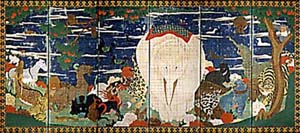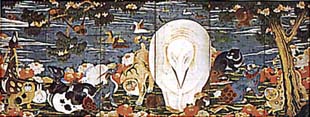Paradise in Illusion by Japanese Artista in Modern Ages
The main purpose of this exhibition is to reunite two sets of six-fold screens that had long been possessed separately in the US and Japan.
One set has been possessed by the Shizuoka Prefectural Museum of Art named "Birds and Animals in the Flower Garden"(a set of six-fold screens).
The other set is owned by The Shin'enkan Foundation in Los Angels.It is a part of the Price collection which represents Japanese Art collectors in America.It's named "Bird, Animals and Flowering Plants"
Both pieces are meticulously coloured and are full of unique animals and birds, using very similar painting methods.
However, neither of them have any data or documents that explain details of the painter's lives or historical background of the screeens.
In ordred to understand these art worksproperly,it is necessary to study about their painting styles carefully. Both paintings were made with special techniques to bring about the sense of perspective and shadow. A grid of 1 centimeter squares was drawn across the screen creating innumerable measuring points.The lines are drawn with light touch of Sumi.Subtle gradation is expressed from light to dark in deep color changes...with dark blues greens, whites, tans, red-oranges, and browns.
By placing big spreading trees on both of the screens, drawing many large flowers in the foreground, and putting rich waterfront in the back-ground, a unique world that is entirely isolated is created.
It is quite amazing how diverse the pictures are when we look at the managerie including a lion, a mythological giraffe, a deer, a bear, a rabbit arranged around a white elephant on the right hand screen, and compare it to the collection of birds including a chicken, a turkey, a peacock a pheasant, a mandarin duck, a golden pheasant all centered around Chinese Phoenix.
There are two points to note: its conceptand painting technique. One is that there is a close relationship with dyeing and weaving. The other is that there are subtle differences between the two screens. There are differences in perspective, light and shadow, and also in painters' ability.
When comparing two sets of screens, the one which is possessed by our Museum can be expressed as cloth-like and has a sense of texture which also has a characteristics of disunity. In contrast, the other screen which has sense of unity, owned by The Shin'en kan foundation gives the audience a plain impression.
And the nature of this Shien'en kan screen becomes more distinct by the use of tropme l'oeil around the circumference on both sets of the screens to give the illusion of a clothlike border. Moreover, most of the animals and birds drawn on the screens are very rare and are believed to have come from tropical countries.
But at the same time, they also represent traditional motifs in Chinese and Buddhist paintings.
The rare foreign animals and birds: ele-phants, two-humped camels and cassowaries were believed to have arrived at port of Nagasaki (Southern part of Japan) during the Edo period. The center point of both screens, the white elephant, is the one that was used to carry Fugenbosatsu who was worshiped widely by the aristocrats.
This elephant is seen in the art piece known as "Fugenbosatsu" (Samantabhadra, middle of 12th century, Tokyo National Museum, National Treasure) The Chinese Phoenix is a make-believe good luck bird which was believed to have appeared during the Golden age of each dynasty.
Mythological giraffes and cranes also repre-sent symbols of good luck and long life. These screens contain both new and old symbols and thoughts by depicting exotic foreign birds and animals, and classical ones.
This unique painting can be expressed with words like "Richness", "silence","bizzar" "innocence", and "celibitory".Due to this incredible art work, both screens from Shizuoka Prefectural Museum and The Shin'enkan Foundation have the nature of "imaginative paradise", though they are basically mere "Birds and Flower Paintings".
Also, they have been drawing much attention recently as they were created under the great influence of a unique Japanese painter Jakuchu Ito(1716-1800), who is a representative of Edo period artists.
Therefore, these screens are very important works of art that convey the world of rich Edo period art, eventhough there is no detailed information on their creation process and the way they have been handed down.
|

 Japanese
Japanese



 Copyright (c) 1997 Shizuoka Prefectural Museum of Art
Copyright (c) 1997 Shizuoka Prefectural Museum of Art